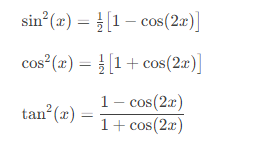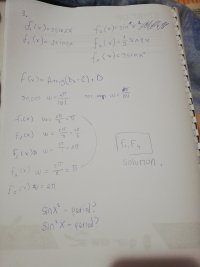You are using an out of date browser. It may not display this or other websites correctly.
You should upgrade or use an alternative browser.
You should upgrade or use an alternative browser.
Find which functions have the same period
- Thread starter Loki123
- Start date
I would prefer to do this without a graph if that's possible.What is f3 and f5?
Look at the graphs of sinx^2 and sin^2x and see if there is a period. If there is, then what is it? Then prove that this result is correct.
BigBeachBanana
Senior Member
- Joined
- Nov 19, 2021
- Messages
- 2,182
Use double angle formula [math]\cos(2x)=1-2\sin^2(x) \Rightarrow \sin^2(x) =\frac{1}{2}(1-\cos(2x))[/math]What's the period of the last expression?
[imath]\sin(x^2)[/imath] is not periodic
[imath]\sin(x^2)[/imath] is not periodic
Last edited:
lev888
Elite Member
- Joined
- Jan 16, 2018
- Messages
- 2,940
I don't know how to find the period of a function in general. If you think the period is P, then you can confirm it by proving that f(x+P) = f(x).I would prefer to do this without a graph if that's possible.
Steven G
Elite Member
- Joined
- Dec 30, 2014
- Messages
- 14,396
I respect that, but still look at the graph just to confirm that it is periodic. If it is not periodic then try to show why that is so and if it is periodic then show that it is. This is the way to do mathematics. Use the graph just to confirm whether if it is or is not periodic.I would prefer to do this without a graph if that's possible.
Pi is the period of cos2x, is that the period of sin^2x?Use double angle formula [math]\cos(2x)=1-2\sin^2(x) \Rightarrow \sin^2(x) =\frac{1}{2}(1-\cos(2x))[/math]What's the period of the last expression?
[imath]\sin(x^2)[/imath] is not periodic
Why is sinx^2 not periodic? Does that also apply to cosx^2, tanx^2 and cotx^2?Use double angle formula [math]\cos(2x)=1-2\sin^2(x) \Rightarrow \sin^2(x) =\frac{1}{2}(1-\cos(2x))[/math]What's the period of the last expression?
[imath]\sin(x^2)[/imath] is not periodic
BigBeachBanana
Senior Member
- Joined
- Nov 19, 2021
- Messages
- 2,182
Correct. Multiply or adding constant does not change the period of [imath]\cos(2x)[/imath]. You have the general transformation of trigonometric function in the OP. The period is determined by [imath]\omega = \frac{2\pi}{|B|}[/imath]Pi is the period of cos2x
You can prove it by using what @lev888 said in post#6.Why is sinx^2 not periodic? Does that also apply to cosx^2, tanx^2 and cotx^2?
For a function f(x) to be periodic with a period P, we must have
[math]f(x+P)=f(x) ∀x[/math]This implies that [imath]f(x)=f(x+P)=f(x+2P)=f(x+3P)=\dots[/imath] must be true. So, a periodic function of x repeats after equally spaced values of P.
Now, for [imath]\sin(x^2)[/imath]. Suppose [imath]x^2 =0, \pi, 2\pi,3\pi\dots[/imath]. Although these values are equally spaced, the
corresponding values [imath]x = 0, \sqrt{π}, \sqrt{2π},\sqrt{3π},\dots[/imath] are not equally spaced.
Use a similar idea for the other trig functions.
Last edited:
D
Deleted member 4993
Guest
Why is sin(x) periodic?Why is sinx^2 not periodic? Does that also apply to cosx^2, tanx^2 and cotx^2?
Because it repeats its values for every 2pi (might have worded this poorly)Why is sin(x) periodic?
Well it would be the same for all of them since they would have have square roots. So trigx^2 is not periodic.Correct. Multiply or adding constant does not change the period of [imath]\cos(2x)[/imath]. You have the general transformation of trigonometric function in the OP. The period is determined by [imath]\omega = \frac{2\pi}{|B|}[/imath]
You can prove it by using what @lev888 said in post#6.
For a function f(x) to be periodic with a period P, we must have
[math]f(x+P)=f(x) ∀x[/math]This implies that [imath]f(x)=f(x+P)=f(x+2P)=f(x+3P)=\dots[/imath] must be true. So, a periodic function of x repeats after equally spaced values of P.
Now, for [imath]\sin(x^2)[/imath]. Suppose [imath]x^2 =0, \pi, 2\pi,3\pi\dots[/imath]. Although these values are equally spaced, the
corresponding values [imath]x = 0, \sqrt{π}, \sqrt{2π},\sqrt{3π},\dots[/imath] are not equally spaced.
Use a similar idea for the other trig functions.
How about trig^2(x)
We know for sin^2(x) it's pi.
Is forr cos^2(x) pi?
For tan^2(x) and cot^2(x) I am having trouble.
BigBeachBanana
Senior Member
- Joined
- Nov 19, 2021
- Messages
- 2,182
The half-angle identities can be re-stated by squaring each side and doubling all of the angle measuresWell it would be the same for all of them since they would have have square roots. So trigx^2 is not periodic.
How about trig^2(x)
We know for sin^2(x) it's pi.
Is forr cos^2(x) pi?
For tan^2(x) and cot^2(x) I am having trouble.

Yes i got that, but how do I determine period if cos2x is diving cos2x?The half-angle identities can be re-stated by squaring each side and doubling all of the angle measures
View attachment 30525
BigBeachBanana
Senior Member
- Joined
- Nov 19, 2021
- Messages
- 2,182
I believe you're referring to [imath]\tan^2(x)[/imath]. It's been a while but it can be shown that the periodicity of [imath]\tan^n(x)= \pi[/imath]Yes i got that, but how do I determine period if cos2x is diving cos2x?

